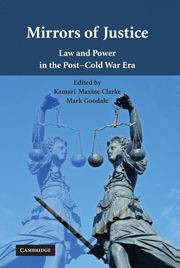Book contents
- Frontmatter
- Contents
- Editor Biographies
- Contributors
- Acknowledgments
- Introduction: Understanding the Multiplicity of Justice
- 1 Beyond Compliance: Toward an Anthropological Understanding of International Justice
- PART I JUSTICE AND THE GEOGRAPHIES OF INTERNATIONAL LAW
- PART II JUSTICE, POWER, AND NARRATIVES OF EVERYDAY LIFE
- PART III JUSTICE, MEMORY, AND THE POLITICS OF HISTORY
- 11 Impunity and Paranoia: Writing Histories of Indonesian Violence
- 12 National Security, Weapons of Mass Destruction, and the Selective Pursuit of Justice at the Tokyo War Crimes Trial, 1946–1948
- 13 Justice and the League of Nations Minority Regime
- 14 Commissioning Truth, Constructing Silences: The Peruvian Truth Commission and the Other Truths of “Terrorists”
- Epilogue: The Words We Use: Justice, Human Rights, and the Sense of Injustice
- Index
- References
11 - Impunity and Paranoia: Writing Histories of Indonesian Violence
Published online by Cambridge University Press: 25 January 2010
- Frontmatter
- Contents
- Editor Biographies
- Contributors
- Acknowledgments
- Introduction: Understanding the Multiplicity of Justice
- 1 Beyond Compliance: Toward an Anthropological Understanding of International Justice
- PART I JUSTICE AND THE GEOGRAPHIES OF INTERNATIONAL LAW
- PART II JUSTICE, POWER, AND NARRATIVES OF EVERYDAY LIFE
- PART III JUSTICE, MEMORY, AND THE POLITICS OF HISTORY
- 11 Impunity and Paranoia: Writing Histories of Indonesian Violence
- 12 National Security, Weapons of Mass Destruction, and the Selective Pursuit of Justice at the Tokyo War Crimes Trial, 1946–1948
- 13 Justice and the League of Nations Minority Regime
- 14 Commissioning Truth, Constructing Silences: The Peruvian Truth Commission and the Other Truths of “Terrorists”
- Epilogue: The Words We Use: Justice, Human Rights, and the Sense of Injustice
- Index
- References
Summary
Historical narratives play important roles in institutions designed to address the legacies of mass violence. Truth commissions are explicitly designed to provide public and official contexts for narrating the unspeakable and locating responsibility for crimes against humanity. The assumption that “revealing is healing” (Adam and Adam, 2001) underlies many strategies for addressing the legacies of massive violence: Expressing or exposing previously denied, secreted, or silenced truths about state violence is said to provide victims with dignity and closure (du Toit, 2000; Hayner, 2001; Minow, 1998; Popkin and Rhot–Arriaza, 1995), as well as to reconcile former enemies and resolve the lingering community-level conflicts that follow violent regimes and armed resistance movements. Trials and international tribunals that identify perpetrators and hold them judicially accountable also produce and authorize new narratives about past atrocities, assigning responsibility for creating conditions that made massive violations of human rights possible. Providing a secure foundation for the rule of law, many advocates agree, requires a comprehensive accounting for the past. Lively legal and academic debate has turned on the role of war crimes trials in documenting systematic atrocities, creating historical memory, and raising public awareness of offenses against human rights (Douglas 2001; Osiel 1997), as distinct from adhering strictly to the requirements of the judicial process for determining culpability (Arendt, 1964; Buruma, 1994). Both tasks are essential, but it is difficult to accomplish both in a single body while upholding notions of historical documentation and institutional responsibility, on the one hand, and standards of due process and individual rights, on the other (Landsman, 2005).
- Type
- Chapter
- Information
- Mirrors of JusticeLaw and Power in the Post-Cold War Era, pp. 229 - 247Publisher: Cambridge University PressPrint publication year: 2009



